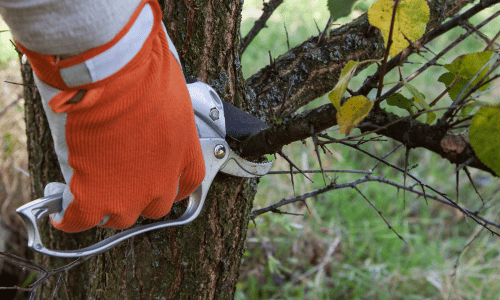Welcome, homeowners, to an enlightening journey into the world of tree pruning. Pruning is not merely an act of snipping branches; it is an art form that requires finesse, knowledge, and a deep understanding of tree biology. In this blog, we will explore the intricate techniques and principles of tree pruning. By the end, you will be equipped with the knowledge to enhance the health, aesthetics, and safety of your trees through proper pruning practices.
The Purpose and Benefits of Tree Pruning:
Before delving into the techniques, it is essential to understand the purpose and benefits of tree pruning. Pruning serves multiple purposes, including:
- Enhancing the tree’s structural integrity and stability.
- Promoting healthy growth and maintaining a desirable shape.
- Removing diseased, damaged, or dead branches.
- Increasing sunlight penetration and airflow within the canopy.
- Managing tree size and preventing interference with structures or utilities.
- Enhancing aesthetics and visual appeal.
Understanding Tree Biology:
To become proficient in tree pruning, it is crucial to grasp the basic principles of tree biology. Trees have a natural ability to compartmentalize and heal wounds. Understanding how they respond to pruning cuts will help you make informed decisions and minimize the potential for damage.
Learn about the branch collar—the swollen area where a branch attaches to the trunk or another branch. Proper pruning techniques involve making cuts just outside the branch collar to avoid injuring the tree’s natural defense systems.
Timing and Seasonal Considerations:
Timing is critical when it comes to tree pruning. Different tree species have specific optimal pruning times to maximize results and minimize stress. Generally, it is best to prune deciduous trees during their dormant season, typically in late winter or early spring before new growth begins. Pruning during this period promotes rapid healing and minimizes the risk of disease or pest infestation.
However, some trees, such as flowering ornamentals, may require pruning immediately after they bloom. Research the specific pruning requirements for each tree species in your landscape to ensure proper timing.
Types of Tree Pruning:
Understanding the different types of pruning techniques is essential for achieving specific objectives. Here are some common types of tree pruning:
- Crown Cleaning: This involves the removal of dead, diseased, or broken branches, promoting the tree’s overall health and appearance.
- Crown Thinning: This technique involves selectively removing branches to improve airflow and light penetration within the canopy. Thinning reduces the tree’s density without altering its overall shape.
- Crown Raising: Raising the crown involves removing lower branches to provide clearance for pedestrians, vehicles, or structures. This technique is particularly important near roads, sidewalks, and buildings.
- Crown Reduction: Sometimes, it may be necessary to reduce the size of a tree’s crown to address space constraints or prevent structural issues. Proper pruning techniques are crucial to maintain the tree’s health and aesthetics during the reduction process.
Tools and Equipment:
To execute proper tree pruning, it is essential to have the right tools at hand. Invest in high-quality pruning tools, including hand pruners, loppers, pruning saws, and pole pruners. Ensure the blades are sharp and clean to create clean cuts that promote quick healing.
Before pruning, sanitize your tools with a disinfectant to prevent the spread of diseases between trees. Remember to wear personal protective equipment, such as gloves and safety glasses, to protect yourself during the pruning process.
Pruning Techniques:
Mastering pruning techniques is the key to achieving desired results while minimizing the negative impacts on tree health. Here are some essential techniques to follow:
- Make cuts just outside the branch collar, avoiding leaving stubs or cutting into the collar itself.
- Use proper pruning angles to facilitate healing and prevent water accumulation on cut surfaces.
- Avoid over-pruning or excessively thinning the canopy, as it can stress the tree and disrupt its natural growth patterns.
- Remove competing or crossing branches to alleviate structural conflicts.
- Prune branches selectively, rather than removing large sections of the canopy all at once.
- Regularly step back and reassess the tree’s shape and structure throughout the pruning process to maintain a balanced and visually pleasing form.
Seeking Professional Help:
While many pruning tasks can be handled by homeowners, there are instances where professional assistance is warranted. Large trees, trees near power lines, or those requiring extensive pruning should be entrusted to certified arborists with the necessary skills, knowledge, and equipment.
Consulting with an arborist can provide invaluable guidance on tree health, specific pruning techniques, and long-term management strategies for your landscape.
Aftercare and Maintenance:
Proper aftercare is crucial to maximize the benefits of pruning and ensure the tree’s continued well-being. Regularly monitor the pruned tree for signs of stress, such as dieback, insect infestation, or disease. Provide adequate water, mulching, and appropriate fertilization to support the tree’s recovery and ongoing growth.
Conclusion:
As we conclude this comprehensive guide on understanding tree pruning techniques, I hope you feel empowered to embark on the journey of enhancing the health, aesthetics, and safety of your trees. Remember, tree pruning is an art that requires knowledge, patience, and careful consideration of tree biology.
By implementing proper pruning practices, you can cultivate healthier trees, promote their natural beauty, and create safer environments around your home. Enjoy the fulfilling process of nurturing your trees and transforming your landscape into a harmonious sanctuary of natural splendor.

